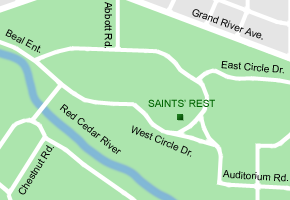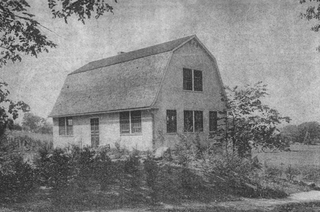
Michigan State University is a public land-grant research university in East Lansing, Michigan, United States. It was founded in 1855 as the Agricultural College of the State of Michigan, the first of its kind in the country. After the introduction of the Morrill Act in 1862, the state designated the college a land-grant institution in 1863, making it the first of the land-grant colleges in the United States. The college became coeducational in 1870. Today, Michigan State has facilities all across the state and over 634,000 alumni.

The University of Massachusetts Amherst is a public land-grant research university in Amherst, Massachusetts, United States. It is the flagship campus of the University of Massachusetts system, and was founded in 1863 as the Massachusetts Agricultural College. It is also a member of the Five College Consortium, along with four other colleges in the Pioneer Valley.

Saints' Rest was the second building erected on the campus of the Agricultural College of the State of Michigan. It was built in 1856 and served as the school's only dormitory until 1870, when Williams Hall was completed. Along with College Hall and a horse barn, it was one of three buildings completed when the college opened for classes in 1857.

College Hall was the first building erected on the campus of the Agricultural College of the State of Michigan, and the first in the United States to be erected "for the teaching of scientific agriculture." Reputedly designed by John C. Holmes, it was built in 1856 and housed the school's classrooms, offices and laboratories, the school's library/museum, and a multifunction lecture hall/chapel. Along with Saints' Rest, and a horse barn, it was one of three buildings completed when the college opened for classes in 1857.
Laboratory Row is a collection of buildings at Michigan State University's campus in East Lansing, Michigan. Built in the late 19th and early 20th centuries it comprises the oldest collection of buildings on campus. The site originally was dedicated to the school's first farming facilities, but as the college outgrew its first buildings additional academic space was needed. In all, seven buildings were built, of which six survive today.
The history of Michigan State University dates back to 1855, when the Michigan Legislature established the Agricultural College of the State of Michigan under the encouragement of the Michigan State Agricultural Society and the Michigan Farmer, the state's leading agricultural periodical. As the first agricultural college in the United States, the school served as a model for other institutions of its kind established in the period, to give an instance, the Agricultural College of Pennsylvania.

The campus of Michigan State University is located in East Lansing on the banks of the Red Cedar River, and comprises a contiguous area of 5,200 acres (21 km2), 2,000 acres (8.1 km2) of which are developed. Built amid virgin forest, the campus opened in 1855 with three buildings, none of which remain. As an agricultural college, the campus was originally located several miles outside of the city of Lansing, but as the population of the college grew, the city of East Lansing developed just north of the area's main avenue.
The Presidential Early Career Award for Scientists and Engineers (PECASE) is the highest honor bestowed by the United States federal government on outstanding scientists and engineers in the early stages of their independent research careers. The White House, following recommendations from participating agencies, confers the awards annually. To be eligible for a Presidential Award, an individual must be a U.S. citizen, national, or permanent resident. Some of the winning scientists and engineers receive up to a five-year research grant.

Demonstration Hall is a structure on the campus of Michigan State University. It was built in 1928 with offices, classrooms, and a riding arena for the Military Science department as a replacement for the Armory. Exhibitions of agricultural stock and implements were held here, as well as athletic events. It served as the home court for the Michigan State Spartans men's basketball team from 1930 to 1940, and the ice rink for the Michigan State Spartans men's ice hockey team from 1949 until Munn Ice Arena was completed in 1974.

John Clough Holmes was an American agriculturalist, educator, and co-founder of the Michigan State Agricultural Society. Holmes is also known as the founder of Michigan State University, established in 1855 as an agriculture college, the first of its kind in the United States. Holmes Hall, the home of the Lyman Briggs College, is named in his honor.

The John W. Lederle Graduate Research Center, also known as Lederle Tower or LGRT, is a building in Amherst, Massachusetts. It is part of the University of Massachusetts Amherst. It contains research laboratories, conference rooms, and offices for many departments within the College of Natural Sciences. There is also a substantial amount of classroom space, formerly teaching laboratories, and a large seminar room. The building is also connected to the Lederle Lowrise and other surrounding buildings.

The East Ridge Historical Area of UMass Amherst consists of several of the older lecture halls on campus, primarily those used by the entomology, plant pathology and other natural science programs. These buildings were originally located adjacent to the campus orchard where the Central Residential Area currently stands today. The district consists mainly of lecture halls that were built prior to the First World War by the Massachusetts Agricultural College; however, it is also home to the Boltwood-Stockbridge House, the oldest house in Amherst.

The Justin S. Morrill Science Center, more commonly known as the Morrill Science Center is a research center, lecture hall, and faculty office complex serving the College of Natural Sciences at the University of Massachusetts Amherst. It comprises four buildings that contain research laboratories for several different programs, including the biochemistry, biology, geosciences, microbiology, and public health departments.

The Ellis Drive Historical Area is an older section of the UMass Amherst containing many of the university's earliest laboratory buildings. Several of these buildings have since been converted for other uses, but research still continues in many of them to this day.

The Chestnut Ridge Historical Area contains a number of the oldest buildings on the University of Massachusetts Amherst campus in the US, including its iconic chapel, the campus war memorial, the W. E. B. Du Bois Library and the last remaining barn from the founding years of the Massachusetts Agricultural College.

Fernald Hall is the primary lecture hall and laboratory used by the entomology program of the University of Massachusetts Amherst. The building also houses the university's extensive collection of domestic and foreign insects.

The Draper Hall Annex is a single-story office building which houses emergency medical services at the University of Massachusetts Amherst. The building is adjoined to Draper Hall, and has served as an office space, classroom, and at one time, home to the university's polymer science research.

The Apiary Laboratory, more often referred to as the Apiary, is a research laboratory at the University of Massachusetts Amherst. Originally built for the study of honey bees and apiculture, today it is primarily used to study native pollinator species and the chemicals and pathogens impacting their populations. This academic building is unique in that it is credited as being the first in the United States to be erected exclusively for the teaching of beekeeping.

The campus of the University of Massachusetts Amherst is located nearly entirely in Amherst, Massachusetts, United States, with a portion located in Hadley. Founded on 310 acres in rural Western Massachusetts, the campus has grown to nearly 1,450 acres.

















